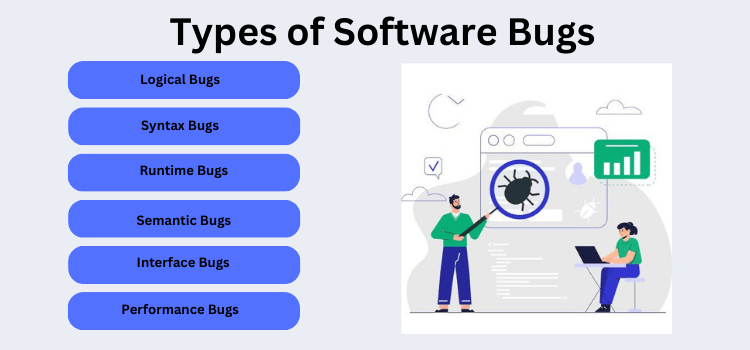What is a Software Bug?
In our tech-driven era, software is an integral part of our daily lives. But often, it doesn’t behave as expected. These inconsistencies or glitches are known as software bugs. Now, why does software have bugs? It’s a prevalent question, especially given the exponential rise of software applications around us.
A software bug is essentially a flaw or error causing the software to behave incorrectly. There are lots of ways bugs can happen – misinterpretations during coding, oversights in design, or unexpected user inputs. Hence, the question remains: what causes the software to be buggy?
Sometimes it’s a human oversight; at other times, it’s the complex nature of integrations or evolving software environments.
Understanding the origin and types of software bugs is vital for developers and testers alike. By identifying and rectifying these bugs, we can ensure smoother, more efficient software operations.
Real-World Software Bugs Examples
Now let’s look at some real-life examples of software bugs.
The Year 2000 Problem (Y2K Bug)
As we approached the new millennium, many feared that software systems, which represented years in two digits, would confuse 2000 with 1900. This is a classic instance showcasing why software has bugs due to historical design choices.
Apple’s Daylight Saving Glitch
iPhone users were in for a rude awakening, quite literally. In 2010, a bug caused alarms to ring an hour late in Australia, highlighting the unpredictability of software bug examples.
Intel’s Pentium FDIV Flaw
Back in 1994, Intel faced a significant challenge. Their Pentium chip had a bug leading to inaccurate results in division operations. This incident underlines the vast impact even minute software bugs can have.
These examples showcase the multifaceted nature of software bugs. They also reiterate the significance of understanding why software has bugs, allowing for more proactive solutions in the tech realm.

Types of Software Bugs
Software is crafted by human minds, and just as humans are not perfect, the software isn’t either. It is important to ask why software has bugs.
It’s a conundrum that has developers, great testers, and even users scratching their heads. To gain a better understanding, it’s essential to first recognize the different types of software bugs that exist.
Logical Bugs
How come software has bugs, especially when all seems fine on the surface? The culprit often is a logical bug. These are the most common bug types and are caused by errors in the logic or algorithm of a program.
A software might run smoothly, but the outcome isn’t what you expect because of flawed reasoning in the code. Logical bugs can be challenging to spot since the software doesn’t crash or produce any error messages.
Syntax Bugs
One of the fundamental reasons why software has bugs. Syntax bugs arise from errors in the code’s syntax, like a missing semicolon or a mismatched bracket.
These are relatively straightforward to detect since most modern compilers and interpreters will flag them.
Runtime Bugs
These bugs generally appear during the program’s runtime. They can be due to invalid user input, file unavailability, or trying to use a null reference. The program might crash, freeze, or produce incorrect results.
Understanding these software bug examples can help in crafting more robust code.
Semantic Bugs
Ever wondered why software has bugs even when everything seems syntactically correct? Semantic bugs are to blame. They occur when the code is syntactically perfect but has an incorrect meaning or intention.
It’s like writing a grammatically correct sentence in English that doesn’t convey the right message.
Interface Bugs
When different software components interact, there’s potential for a mismatch, leading us back to the question, “Why does software have bugs?”
Interface bugs happen when there’s a miscommunication between these components, especially in large systems or applications integrated with third-party services.
Performance Bugs
Speed and responsiveness are vital in today’s digital age. Performance bugs slow down software or consume excessive resources. Identifying and rectifying these software errors ensures that applications run efficiently.

Why Does Software Have Bugs?
The world of software development is intricate, and despite the best efforts of developers, bugs often find their way into the final product. But what causes bugs in software in the first place?
The answers range from human error to the sheer complexity of modern computing. Let’s delve deeper into some of the primary reasons.
Human Errors
At its core, every piece of software is written by humans, and humans are not infallible. Whether it’s a typo, oversight, or a simple misunderstanding of requirements, human errors are among the leading causes of software bugs.
Consider them as the “typos” in the programming world. As the adage goes, “To err is human.” And in software development, even a minor oversight can lead to significant issues.
Complexity and Integration Challenges
Modern software is more sophisticated than ever, often integrating with multiple other systems and platforms. With this integration comes complexity. The more components there are, the higher the chances of something going awry.
So, how come software has bugs? Sometimes, it’s the very sophistication and interconnectedness that’s the culprit.
Evolving Requirements
Software projects often have changing requirements. As projects evolve, earlier parts of the code may become obsolete or incompatible with new features.
This constant evolution can introduce errors if not managed correctly, leading to those pesky software bug examples we often hear about.
Inadequate Testing
While testing is crucial in software development, not all tests cover every possible scenario. Sometimes, the environment where the testing occurs is different from the real-world setting, leading to discrepancies.
What causes software bugs despite rigorous testing? Due to the diversity of devices and operating systems today, it is difficult to anticipate every possible user action.
External Libraries and Dependencies
Many software applications rely on third-party libraries and tools. These external dependencies can sometimes have their own bugs, which inadvertently become part of the integrating software.
In some cases, even if the primary code is perfect, a third-party tool that isn’t updated or has issues can explain why software has bugs.
Tight Deadlines
In the fast-paced world of tech, there’s often a race to launch products quickly. Tight deadlines can sometimes result in developers rushing through the coding process, and making mistakes along the way.
In the haste to meet release dates, some types of software bugs might be overlooked.
What’s the Role of Bug Testing in Developing Quality Software?
Have you ever wondered about the backbone that ensures your software runs smoothly? It’s the rigorous phase of bug testing. Let’s dive into understanding its significance.
Upping the Software Game
At its essence, bug testing zeroes in on those sneaky issues, big or small, that can dampen the software’s performance. It’s like a detective sleuthing out errors before they wreak havoc.
And guess what? This method not only amps up the software’s reliability but also ensures that users have a seamless experience. It’s akin to fitting the last piece in a jigsaw puzzle, making sure every user move aligns perfectly with the software’s response.
Plus, a sturdy bug testing routine is a fortress against harmful external threats.
Three Pillars of Bug Testing
Curious about why bug testing is the talk of the tech town? Here are three reasons —
Quality Over Everything
Crafting software without ensuring it meets high standards? That’s a no-go. Bug testing is the quality stamp every software needs.
An Inseparable Duo
Just like bread and butter, designing software and testing it go hand-in-hand. One’s incomplete without the other.
The Final Report Card
Want to gauge how your software fares? Bug testing is your answer. It offers insights into the software’s overall prowess.
When Human Touch Adds Glitches
Humans, with all their brilliance, are prone to slip-ups. Whether it’s during the initial stages or the final rollout, errors can creep in. These hiccups can range from trivial ones, like a misspelled word, to monumental ones, like a system crash.
Hence, bug testing becomes the unsung hero, catching these missteps and ensuring a flawless software experience.
Wrapping up
As we come to the end of our question “why does software have bugs?”, it’s evident that flawless software isn’t about luck. It’s about meticulous planning, rigorous testing, and continuous improvement.
Bug testing, in essence, acts as the final barrier between potential software issues and the end user, ensuring an optimal user experience. Remember, even with the most advanced tools and talented developers at hand, human errors are inevitable.
It’s through diligent testing that we can navigate and rectify these challenges. As software continues to dominate every facet of our lives, its quality is paramount, and bug testing remains its most trusted guardian.
Frequently Asked Questions
Why is bug testing crucial?
Bug testing acts as a safety net, catching flaws and vulnerabilities before they reach the end-user. It’s an integral phase to ensure the software’s reliability and security.
Does every software need bug testing?
Absolutely! Regardless of the software’s size or purpose, every piece of software benefits from thorough bug testing to ensure its functionality and safety.
How often should software undergo bug testing?
Continuous testing is key. As software undergoes updates or changes, regular bug testing ensures that no new issues have been introduced and that previous problems remain resolved.
- Top 10 Cross Browser Testing Tools: The Best Choices for 2024 - October 28, 2025
- 5 Best API Testing Tools: Your Ultimate Guide for 2024 - October 26, 2025
- Top 5 Regression Testing Tools: Comprehensive Review & Guide - October 26, 2025
